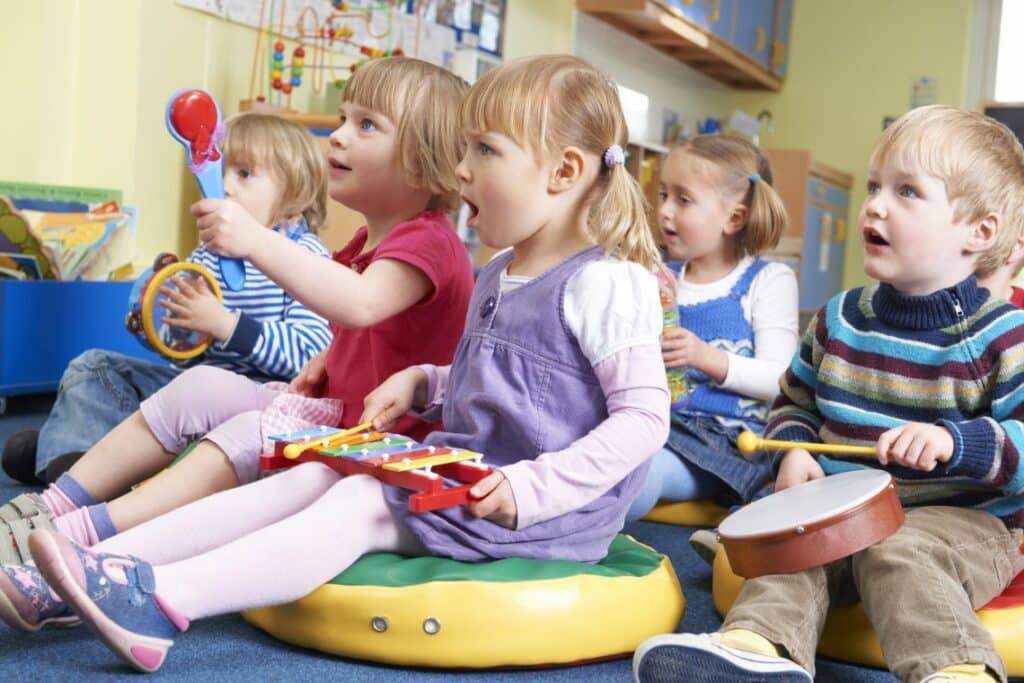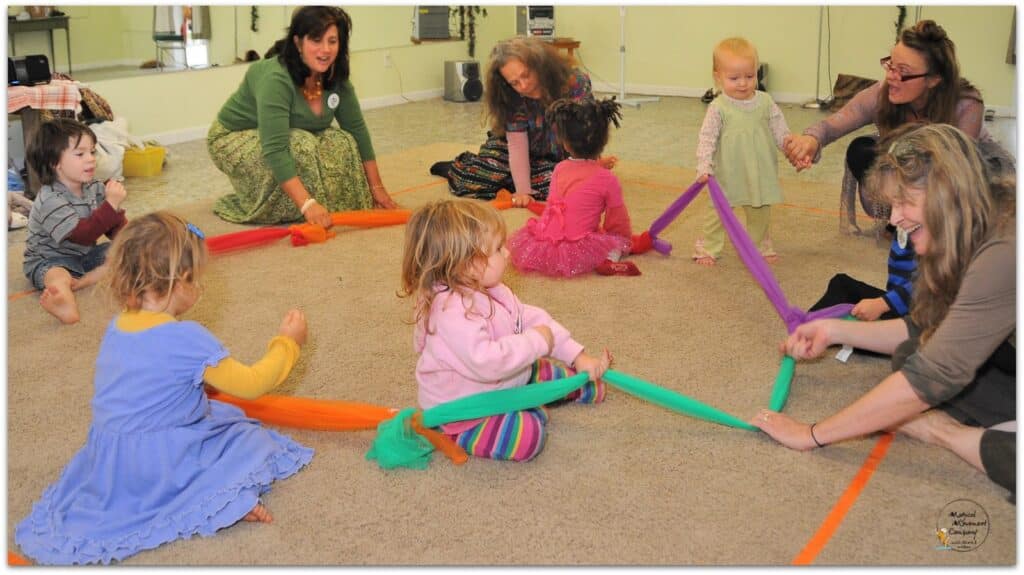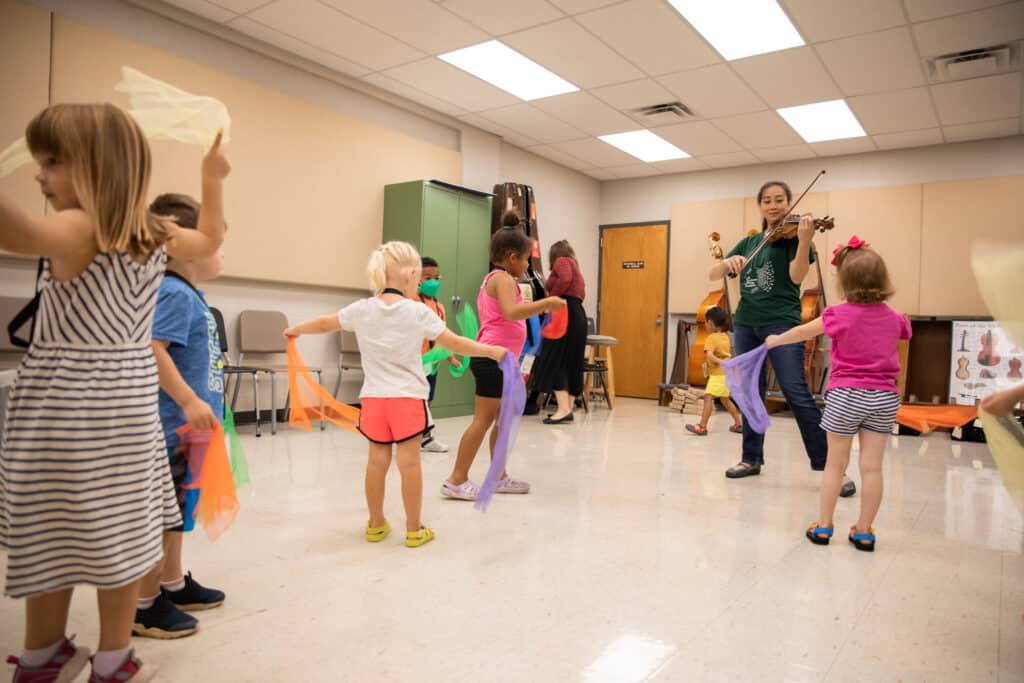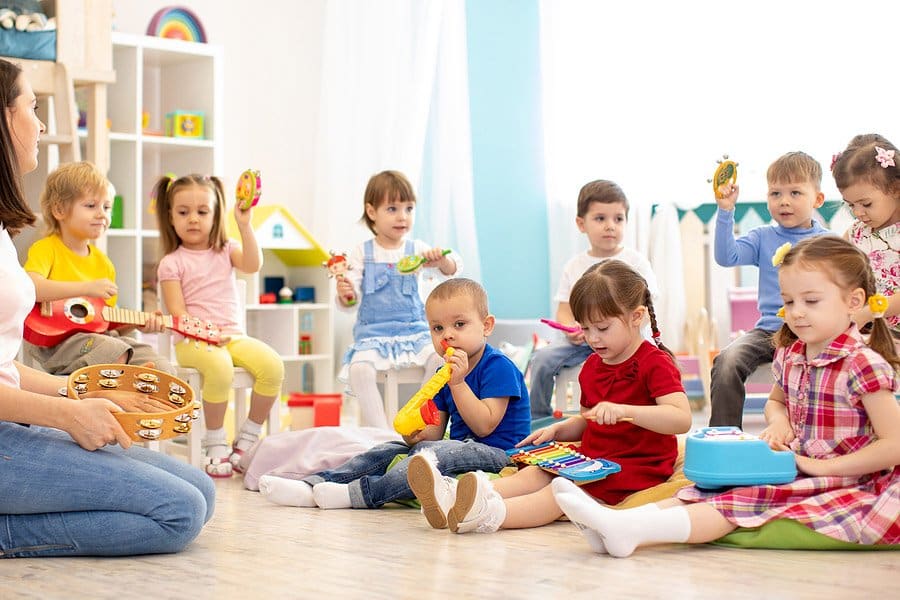Music and movement play an integral role in the Montessori classroom and, as such, are incorporated into daily activities. Music and movement receive the same attention in the Montessori classroom as other subjects in the curriculum, as they are considered equally important.
Music and movement are integrated into the daily life of the Montessori classroom. Children are given ample opportunity to engage in music and movement through hands-on experimentation in the prepared classroom.
Dr. Maria Montessori believed that music should play a role in every aspect of teaching in the Montessori method. Here we explore the important role played by music and movement in a Montessori classroom.

What is the Role of Music and Movement in the Montessori Classroom?
Music and movement play a role in every aspect of daily life in the Montessori classroom. If you have ever entered a Montessori classroom, you will see children moving about the space as they wish. The Montessori classroom is prepared with purpose every day so that the children can choose from numerous activities designed to aid their development.
There are many benefits associated with music and movement, which Dr. Maria Montessori understood. The role of music and movement is to encourage cognitive development and develop fine and gross motor skills while strengthening social and language skills.
Music teaches children to listen with purpose. The different notes and sequential nature that characterize music and songs help children understand sequences, which helps with their problem-solving ability.
The belief is that all children have the potential to sing in tune, play an instrument or read music when they are given the opportunity to do such things during early childhood. In a Montessori classroom, children learn music and movement by engaging their senses. The children can interact with music through hands-on experimentation. Movement can be introduced through guided music and movement activities.
Children in a Montessori classroom are exposed daily to music through materials such as the Montessori bells. Through the bells, children learn how to differentiate between sounds, which in turn helps with literacy and language development.
“There should be music in the child’s environment, just as there does exist in the child’s environment spoken speech. In the social environment the child should be considered, and music should be provided.”–Maria Montessori

The Multifaceted Benefits of Montessori Music and Movement Education
Music and movement play a crucial role in Montessori classrooms by fostering children’s cognitive, emotional, and physical development. These activities align with the Montessori philosophy of nurturing the whole child, promoting creativity, and enhancing learning experiences through sensory engagement.
1. Cognitive and Language Skills Development through Music
Music plays a significant role in the cognitive and language development of children. Through musical activities, children learn to recognize patterns, enhance memory, and develop a deeper understanding of language.
Enhances Memory and Concentration
When children sing or play musical instruments, they exercise their memory and concentration. Remembering lyrics and melodies helps to strengthen their cognitive abilities and improve focus. Studies have shown that children exposed to music from an early age tend to perform better academically.
Supports Language Acquisition
Music is inherently rhythmic and melodic, which mirrors the natural flow of spoken language. Children enhance their phonemic awareness, vocabulary, and comprehension skills by engaging in musical activities. For instance, learning new songs introduces them to new words and phrases, fostering their linguistic abilities.
Encourages Creative Expression
Music allows children to express themselves creatively. Children explore their creativity and develop their unique voices by composing simple melodies or improvising rhythms. This creative expression is crucial for building confidence and individuality.
2. Enhancement of Motor Skills and Physical Development
Movement activities are fundamental in Montessori education, promoting the physical development of children. These activities help refine fine and gross motor skills, essential for overall physical health and coordination.
Development of Fine Motor Skills
Fine motor skills involve the coordination of small muscles, particularly in the hands and fingers. Playing instruments or clapping to a rhythm helps children develop these skills. For example, playing the piano or drumming requires precise finger movements, which enhance dexterity and hand-eye coordination.
Improvement of Gross Motor Skills
Gross motor skills involve more significant movements using the arms, legs, and entire body. Activities like dancing, jumping, and running are integral to Montessori classrooms. These activities help children develop balance, strength, and coordination. For instance, a dance activity that involves moving to different beats can significantly improve a child’s gross motor skills and physical fitness.
3. Promotes Emotional and Social Growth
Music and movement activities are excellent for promoting emotional and social development in children. These activities allow children to interact, express their emotions, and develop empathy and social skills.
Emotional Expression and Regulation
Music and movement offer a safe space for children to express their emotions. Whether through the joy of singing a happy song or releasing energy in a dance, children learn to recognize and manage their feelings. This emotional regulation is vital for mental well-being and personal development.
Building Social Skills
Group activities involving music and movement require cooperation, turn-taking, and communication. These activities help children build essential social skills like teamwork, leadership, and empathy. For instance, participating in a group dance or band teaches children to work together towards a common goal, fostering a sense of community and belonging.
Enhancing Self-Confidence
As children master new songs, dances, or movements, their self-confidence grows. Successfully learning and performing in front of peers or family members can boost their self-esteem. This increased confidence positively impacts other areas of their lives, encouraging them to take on new challenges enthusiastically.
4. Enhances Literacy Skills
Phonemic awareness is the ability to hear and manipulate sounds in words, a crucial reading skill. Musical activities that involve rhyming, clapping out syllables, or singing songs with repetitive sounds help children develop this awareness. For example, nursery rhymes and rhythmic songs make it easier for children to recognize and play with sounds.
Songs often introduce children to new words and concepts, expanding their vocabulary. Singing about different themes, such as animals, seasons, or emotions, helps children learn new words contextually and memorably. This enriched vocabulary supports their overall language development and literacy skills.
Key Principles for Implementing Montessori Music and Movement Education
1. Provide a Prepared Environment
A prepared environment is foundational to Montessori education. It involves creating a space where children can explore and learn independently. For music and movement, this means having a dedicated area with the right materials and equipment to support these activities.
Setting up a musical corner with various instruments, such as drums, tambourines, and xylophones, allows children to explore different sounds and rhythms. This space should be inviting and accessible, encouraging children to engage with music freely.
A designated area for movement activities is equally important. This space should be large enough for children to move freely and safely. Including mats, balance beams, and other physical activity tools can help children develop their gross motor skills.
2. Foster Individualized and Collaborative Learning Experiences
Montessori education emphasizes individualized learning and collaborative activities. Music and movement provide excellent opportunities for children to learn independently and as part of a group.
3. Embrace Multicultural and Interdisciplinary Connections
Integrating music and movement from various cultures and disciplines enriches the Montessori curriculum. This approach broadens children’s perspectives and fosters a greater appreciation for diversity.
4. Provide Guidance and Direction
While independence is a core principle of Montessori education, providing appropriate guidance and direction is crucial for maximizing the benefits of music and movement activities.
Teachers should show enthusiasm, provide clear instructions, and offer support. Teachers can also introduce new concepts, instruments and activities to help expand children’s horizons and keep them engaged.
How Do You Teach Music in Montessori?
Before we dive into how music is incorporated and taught in a Montessori classroom, it’s necessary to understand the role of a teacher in a Montessori environment.
According to the Montessori approach to education, children learn best through experience and sensory engagement. Music education in a Montessori classroom engages the whole child in the process. This means that the child’s ears, eyes, voice, hands, body (through movement), and soul are all involved in the learning process.
Teaching in a Montessori classroom is different than in a regular classroom environment. The role of the teacher is that of a guide. Teachers demonstrate the carefully chosen and designed activities they have prepared in their classroom for the day. The demonstration is to encourage independent learning and exploration of the materials.
The teacher introduces activities sequentially and will observe how the children interact with the materials throughout each work cycle (work means to play.) Music is treated no differently by the teacher than any other subject.
Music in a Montessori classroom can be taught in the following ways:
- Observed Introduction: The teacher models the activity silently to the children. An exercise or task is demonstrated without verbal instructions for the children. This is so they can interpret how to perform the action or task themselves. The Montessori method encourages children to learn their way of doing something.
- Reinforcement: Reinforcement is when the teacher repeats a demonstration or sings a song several times.
The role of the teacher is to introduce materials or activities and offer support throughout the child-directed engagement of the material. The teacher is there to provide encouragement and guidance. Children learn music through hands-on experimentation, performing a song or piece, listening to music, seeing the notes written down, and learning about composers and musicians.

Why is Music Important in Montessori Education?
Maria Montessori developed five principles for educating children using the Montessori Method. These principles are the absorbent mind, respect for the child, sensitive periods, auto education, and the prepared environment.
These principles mean that each child works in an environment the teacher prepares to promote independence and learning through sensory engagement. Learning occurs in a calm environment designed to ensure the children of the classroom are introduced to work and materials that support development during specific sensitive periods.
Dr. Maria Montessori observed the sensitive period for musical education to be between 3 and 6 years old. That is not to say, however, that those children below or above this age should not engage in musical education or activities!
Music plays a central role in Montessori education because it positively affects a child’s development. Music teaches children to express themselves and their feelings nonverbally. Music helps with cognitive development, promotes spatial awareness, and improves language, reading, and writing skills.
Music helps children learn because when they play an instrument or move while listening to music, more than one sense is engaged. The sensitive periods must be used to their full potential. Children must be presented with numerous musical materials and be able to repeat the activities to promote development.

What Does Montessori Say about Music?
Dr. Maria Montessori, the founder of the Montessori Method, believed that all children have the potential to learn. Dr. Montessori recognized that music is a fundamental spiritual need for humans, which is why humans in every culture create music.
Dr. Montessori observed that the traditional method of education may not suit every child and, therefore, not help them reach their full potential.
“We tend to think that the realm of music is the privileged area of some happy few. Experience has taught us, however, that if offered the right kind of education from a very early age onwards, anyone is capable of entering the realm of music. Not everyone has the talent to practice music at an artistic level, or create new work, but everyone can reach a stage where they can enjoy it.”-Maria Montessori, The Montessori Approach to Music, p. 1
Dr. Montessori believed that music should permeate almost every aspect of the Montessori teaching method because of the ben.
What is Movement in Montessori?
“It is movement that interests the child in music, and it is by movement that the very tiny child can arrive at understanding music with considerable delicacy”– Maria Montessori
Dr. Montessori stressed the importance of movement. Children learn to move in response to their environment, from learning to crawl and walk. Dr. Montessori believed children learn when they move, mainly because movement stimulates different brain sections than when a child passively listens.
Children can move about the environment in a Montessori classroom without asking permission. Children can walk around and choose which materials they want to work with. Children can choose where to sit on the floor or at a table. The children can choose who they would like to socialize with.
The activities or work students can engage in always involve movement. This is because Dr. Montessori believed that learning occurs through movement. This link between movement and learning is why music is integral to childhood development.

What are Some Montessori Music and Movement Activities?
The Montessori method offers many great music and movement activities that help children learn. The activities encourage the development of fine and gross motor skills, creativity, and expression and aids cognitive development.
Here are some materials and music and movement activities a child can engage with in a Montessori classroom:
- The Montessori Bells: The Montessori bells are a set of 26 bells in two groups of 13 – the control set and the work set. The bells are a fantastic material! The bells have a different octave, and each set has a different colored base. With the bells, children learn to distinguish between the different tones. This, in turn, helps children differentiate between the sounds of spoken words, known as phonetics. Activities include making sounds with the bells, pairing the bells, and playing scales with the bells.
- Walking the Line: This is when children walk along a line, usually taped to the floor, to music. Walking the line teaches children balance, coordination and how to control their movements.
- Musical Instrument Identification: In this activity, children choose a musical instrument to hold to see what sound it makes. They then name the instrument.
- Dancing with Silk Scarves: This is a fun way to develop fine motor skills! The children each pick up a silk scarf and dance to classical music.
How Do Music and Movement Work Together in Montessori Education?
In a Montessori classroom, music and movement are not isolated elements but are seamlessly integrated to create a comprehensive learning experience. But how exactly do these two components complement each other in Montessori education?
Synergistic Activities
Activities like rhythm games, musical storytelling, and dance combine music and movement, engaging multiple senses and making learning more immersive. For example, children might learn about different cultures through traditional dances and songs, enhancing their understanding of global diversity.
Benefits of Multisensory Engagement
Engaging multiple senses enhances memory retention and comprehension. When children listen to music while moving, they develop a deeper connection to the material, which supports long-term learning and cognitive development. This multisensory approach aligns with Montessori’s emphasis on hands-on, experiential learning.
Emotional and Social Benefits
Music and movement activities often involve group participation, which helps children develop essential social skills. How do these activities support emotional and social development in a Montessori setting?
Fostering Teamwork and Empathy
Group activities like singing in a choir or participating in a dance routine require children to work together, listen to each other, and coordinate their actions. This teamwork fosters a sense of community and teaches children the importance of collaboration. Additionally, these activities help children learn to negotiate, take turns, and develop empathy.
Emotional Expression through Art
Music is a powerful medium for expressing and understanding emotions. In the Montessori classroom, children are encouraged to explore different musical genres, helping them to identify and articulate their feelings. This emotional intelligence is crucial for their social interactions and overall well-being.
How Can Parents Support Music and Movement at Home?
Parents can play a pivotal role in supporting and enriching their child’s experience with music and movement at home. Here are some practical ways to foster this development:
Create a Musical Environment:
- Play a variety of music: Introduce your child to different genres of music at home. Exposure to diverse musical styles can enhance their auditory discrimination and appreciation from classical and jazz to folk and world music.
- Provide musical instruments: Simple instruments like drums, xylophones, maracas, or even homemade instruments can encourage exploration and self-expression.
Participate in Music and Movement Activities:
- Sing and dance together: Engage in singing, nursery rhymes, and dancing. This makes learning fun and strengthens the bond between you and your child.
- Use movement games: Games like “Freeze Dance” or “Musical Chairs” can be fun ways to incorporate music and movement. Encourage your child to move in different ways by following the rhythms or themes of the songs.
By incorporating these practices, parents can significantly support and enhance their child’s development through music and movement, providing a rich sensory environment that fosters creativity, coordination, and a love for the arts.
Conclusion
Music and movement are integral to the Montessori classroom, offering a myriad of benefits for children’s cognitive, motor, emotional, and social development. By incorporating these activities into daily routines and lessons, educators can create a rich, engaging, and supportive learning environment.
Understanding and utilizing the power of music and movement can help us nurture well-rounded, confident, and happy children who are prepared for lifelong learning and success.













